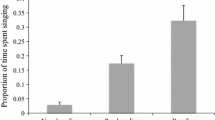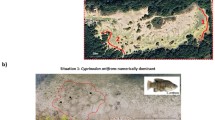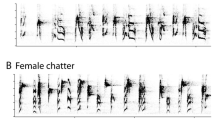Abstract
Both cooperation and conflict between the sexes are commonplace in monogamous mating systems. However, little is known about how cooperation and competition varies seasonally in monogamous species that maintain permanent territories. We presented territorial pairs of male and female New Zealand robins (Petroica australis) with a large supply of insect prey at monthly intervals for 2 years. Behavioural observations after food presentation were then made to quantify seasonal and sexual differences in aggressive interactions over prey, prey acquisition rates, mate provisioning, offspring provisioning, selfish food hoarding and cache retrieval. Data were used to evaluate sex-specific behavioural strategies of mediating competition for food. Results showed that males aggressively excluded females from experimental food sources year-round. Females only accessed food sources when males left them unattended. Consequently, females acquired fewer prey than males. After controlling for differences in prey acquisition, both sexes consumed similar amounts of prey in the non-breeding season. Even though males aggressively excluded females from accessing food sources directly, males fed large amounts of prey to females during the breeding season. Both sexes provisioned young at similar rates. Males cached less prey than females in the breeding season but more prey than females in the non-breeding season. Females showed similar caching intensities year-round. Although males tried to defend their hoards, females frequently retrieved male-made caches. Overall, results showed that although New Zealand robins cooperate to raise offspring during the breeding season, conflict between the sexes occurs year-round. Males and females display different behavioural strategies to gain access to experimental food sources, which appear to lessen male–female competition for food and evenly distribute food resources between the sexes.





Similar content being viewed by others
References
Alexander L, Duthie C, Fyfe J, Haws Z, Hunt S, Montoya I, Ochoa C, Siva A, Stringer L, van Horik J, Burns KC (2005) An experimental evaluation of food hoarding by North Island robins (Petroica australis longipes). Notornis 52:138–142
Ardern SL, Ma W, Ewen JG, Armstrong DP, Lambert DM (1997) Social and sexual monogamy in translocated New Zealand robin populations. Auk 114:120–126
Armstrong DP, Ewen JG, Dimond WJ, Lovegrove TG, Bergström A, Walter B (2000) Breeding biology of North Island robins (Petroica australis longipes) on Tiritiri Matangi Island, Hauraki Gulf, New Zealand. Notornis 47:106–118
Arnqvist G, Rowe L (2005) Sexual conflict. Princeton University Press, Princeton
Arnqvist G, Jones TM, Elgar MA (2006) Sex-role reversed nuptial feeding reduces male kleptoparasitism of females in Zeus bugs (Heteroptera; Veliidae). Biology Letters 2:491–493
Brotons L (2000) Individual food-hoarding decisions in a nonterritorial coal tit population: the role of social context. Anim Behav 60:395–402
Burns KC, Steer J (2006) Dominance rank influences food hoarding in New Zealand robins Petroica australis. Ibis 148:266–272
Burns KC, van Horik J (2007) Sexual differences in food re-caching by New Zealand robins. J Avian Biol 38:394–398
Carlquist S (1965) Island life. Natural History, New York
Carrascal LM, Moreno E (1993) Food-caching versus immediate consumption in the nuthatch: the effect of social context. Ardea 81:135–141
Chapman T, Arnqvist G, Bangham J, Rowe L (2003) Sexual conflict. Trends Ecol Evol 18:41–47
Dall SR, McNamara JM, Wedell N, Hosken DJ (2006) Debating sexual selection and mating strategies. Science 312:689
Dawson JW (1988) Forest vines to snow tussocks: the story of New Zealand’s plants. Victoria University Press, Wellington
Ekman J (1989) Ecology of non-breeding systems in Parus. Wilson Bull 101:263–288
Gibbs G (1998) New Zealand weta. Reed, Auckland
Glase JC (1973) Ecology of social organization in the black-capped chickadee. Living Bird 12:235–267
Hamer KC, Quillfeldt P, Masello JF, Fletcher KL (2005) Sex differences in provisioning rules: responses of Manx shearwaters to supplementary chick feeding. Behav Ecol 17:132–137
Härdling R, Källander H, Nilsson J-A (1995) Experimental evidence for low intra-pair cache pilfering rates in European nuthatches. Proc R Soc Lond, Series B 260:127–130
Higgins PJ, Peter JM (2002) Handbook of Australian, New Zealand and Antarctic birds, vol. 6. Oxford University Press, Victoria
Hinde CA (2005) Negotiation over offspring care? – a positive response to parent-provisioning rate in great tits. Behav Ecol 17:6–12
Houston AI, Székely T, McNamara JM (2005) Conflict between parents over care. Trends Ecol Evol 20:33–38
Jawor JM, Breitwisch R (2006) Is mate provisioning predicted by ornamentation? A test with northern cardinals (Cardinalis cardinalis). Ethology 112:888–895
Johnstone RA, Hinde CA (2006) Negotiation over offspring care—how should parents respond to each other’s efforts. Behav Ecol 17:818–827
Koenig WD, Mumme RL (1987) Population ecology of the cooperatively breeding acorn woodpecker. Princeton University Press, Princeton
Korpimäki E (1987) Prey caching of breeding Tengmalm's owls Aegolius funereus as a buffer against temporary food shortage. Ibis 129:499–510
Lack D (1940) Courtship feeding in birds. Auk 57:169–178
Lahti K (1998) Social dominance and survival in flocking passerine birds: a review with an emphasis on the willow tit Parus montanus. Ornis Fenn 75:1–17
Lahti K, Koivula K, Rytkoenen S, Mustonen T, Welling P, Pravosudo VV Orell M (1998) Social influences on food-caching in willow tits: a field experiment. Behav Ecol 9:122–129
Lee KE (1959) The earthworm fauna of New Zealand. Government Printer, Wellington
Lundborg K, Brodin A (2003) The effect of dominance rank on fat deposition and food hoarding in the willow tit Parus montanus— an experimental test. Ibis 145:78–82
Markman S, Pinshow B, Wright J, Kotler B (2004) Food patch use by parentbirds: to gather food for themselves or for their chicks. J Anim Ecol 73:747–755
McNamara JM, Binmore K, Houston AI (2006) Cooperation should not be assumed. Trends Ecol Evol 21:476–478
Moncrieff P (1932) Notes on the South Island robin. Emu 32:52–58
Murray CM, Eberle LE, Pusey AE (2006) Foraging strategies as a function of season and rank among wild female chimpanzees (Pan troglodytes). Behav Ecol 17:1020–1028
NIWA (2006) National climate centre. Accessed from http://www.niwascience.co.nz/ncc/.
Norušis MJ (2006) SPSS 14.0 advanced statistical procedures companion. Prentice Hall, New York
Powlesland RG (1980) Food storing behaviour of the South Island robin. Mauri Ora 8:11–20
Powlesland RG (1981) The foraging behaviour of the South Island robin. Notornis 28:89–102
Pravosudov VV (2006) On seasonality in food-storing behaviour in parids: do we know the whole story. Anim Behav 71:1455–1460
Roughgarden J, Oishi M, Akcay E (2006) Reproductive social behaviour: cooperative games to replace sexual selection. Science 311:965–969
Soper MF (1976) New Zealand birds. Whitchoulls, Christchurch
Steer J, van Horik J (2007) North island robin (Petroica australis longipes) food caches are stolen by stitchbirds (Notiomystis cincta) and bellbirds (Anthornis melanura). Notornis 53:315–316
Székely T, Thomas GH, Cuthill IC (2006) Sexual conflict, ecology, and breeding systems in shorebirds. BioScience 56:801–808
Tregenza T, Wedell N, Chapman T (2006) Introduction. Sexual conflict: a new paradigm. Philos Trans R Soc Lond B Biol Sci 361:229–234
van Horik J, Burns KC (2007) Cache spacing patterns and reciprocal cache theft in New Zealand robins. Anim Behav 73:1043–1049
Vander Wall SB (1990) Food hoarding in animals. University of Chicago Press, Chicago
Vander Wall SB, Jenkins SH (2003) Reciprocal pilferage and the evolution of food-hoarding behavior. Behav Ecol 14:656–667
Vander Wall S, Briggs JS, Jenkins SH, Kuhn KM, Thayer TC, Beck, MJ (2006) Do food-hoarding animals have a cache recovery advantage? Determining recovery of stored food. Anim Behav 72:189–197
Wedell N, Kvarnemo C, Lessells CM, Tregenza T (2006) Sexual conflict and life histories. Anim Behav 71:999–1011
Wilson K-J (2004) Flight of the Huia. University of Canterbury Press, New Zealand
Yosef R, Pinshow B (1989) Cache size in shrikes influences female mate choice and reproductive success. Auk 106:418–421
Yosef R, Pinshow B (2005) Impaling in true shrikes (Laniidae): a behavioral and ontogenetic perspective. Behav Processes 69:363–367
Zanette L, Clinchy M, Smith JNM (2006) Food and predators affect egg production in song sparrows. Ecology 87:2459–2467
Author information
Authors and Affiliations
Corresponding author
Additional information
Communicated by S. Pruett-Jones
Rights and permissions
About this article
Cite this article
Steer, J., Burns, K. Seasonal variation in male-female competition, cooperation and selfish hoarding in a monogamous songbird. Behav Ecol Sociobiol 62, 1175–1183 (2008). https://doi.org/10.1007/s00265-008-0546-z
Received:
Revised:
Accepted:
Published:
Issue Date:
DOI: https://doi.org/10.1007/s00265-008-0546-z




